Surge in Spectacle Lens Market Driving Innovations and Growth

The Spectacle Lens Market is Expanding Rapidly
The spectacle lens market is poised for remarkable growth, projected to reach a valuation exceeding US$ 108.49 billion by 2033. This surge from US$ 63.35 billion in 2024 represents an impressive compound annual growth rate (CAGR) of 6.16% during the 2025-2033 forecast period. The market's expansion is fueled by the increasing consumer demand for high-quality eyewear, superior comfort, and enhanced vision clarity.
Trends Shaping the Spectacle Lens Market
Consumers today are leaning towards spectacle lenses that not only enhance vision but also complement their style. This emphasis on fashion and functionality is transforming how lens manufacturers approach product design. Companies are creating diverse lens products tailored to various visual needs, including single-vision and progressive lenses. Furthermore, advanced materials like high-index glass and polycarbonate are dominating this landscape, helping to achieve a thin yet durable lens structure essential for maintaining wearability.
Technological Innovations in Lens Production
Recent developments in lens technology are noteworthy. Key players such as Essilor, Zeiss, Hoya, and Nikon are at the forefront of innovation. For instance, Essilor recently unveiled several patented anti-glare solutions that are designed to mitigate the impact of harsh lighting from digital devices. Additionally, Hoya's introduction of advanced lens finishing hubs and Nikon's high-index composites has revolutionized lens manufacturing, promoting thinner, high-performance eyewear.
Consumer Behavior Impacting the Market
Modern consumers are increasingly prioritizing personalized eyewear solutions. The trend towards customizable lens features means consumers expect lenses that fit seamlessly into their daily lives. Essilor and Carl Zeiss have responded by securing significant market shares through innovative direct-to-consumer strategies and advanced customization options. These companies are not just meeting demand; they're leading the way by integrating aesthetic features into their product offerings while also ensuring optimal functionality.
Focus on Eye Health and Digital Protection
The rise in digital device use has amplified the need for protective eyewear. High-quality coatings, such as anti-reflective and blue-light-filtering treatments, have become essential for addressing concerns related to prolonged screen exposure. Seiko Optical and Rodenstock have also recognized this shift, launching innovative products that cater to consumers seeking enhanced visual comfort.
Major Players in the Spectacle Lens Market
The spectacle lens market boasts several key players, with EssilorLuxottica and Carl Zeiss leading the charge. Together, they command more than 37.62% of the market share, significantly influencing industry dynamics. Their extensive research and production capabilities not only assure high-quality outputs but also offer extensive customization to meet diverse consumer needs. In 2023, these companies invested substantial resources into developing cutting-edge technology and improving lens coatings, which has cemented their positions in the market.
Emerging Challenges and Solutions
Alongside opportunities, the spectacle lens market faces certain challenges, including product counterfeiting and inconsistent quality from online vendors. However, robust branding and enhanced distribution strategies are helping established companies maintain consumer trust. Efforts to implement more stringent quality controls and educational outreach have proven effective in reassuring buyers about the integrity of their optical choices.
Conclusion: Future of the Spectacle Lens Market
The future of the spectacle lens market looks bright as innovations continue to reshape consumer expectations. With continuous advancements in technology combined with a keen focus on consumer needs, this industry is set to evolve significantly. As cutting-edge solutions come to the forefront, companies are better positioned to capture the market share and address the diverse needs of eyewear consumers.
Frequently Asked Questions
What is the projected growth of the spectacle lens market?
The spectacle lens market is projected to grow to over US$ 108.49 billion by 2033.
Which companies are leading in the spectacle lens market?
EssilorLuxottica and Carl Zeiss are the leading companies in this sector, commanding substantial market share.
What trends are influencing consumer choices in eyewear?
Consumers are increasingly looking for eyewear that combines style, functionality, and protection from digital screens.
How are technological advancements impacting lens production?
Innovations in materials and coatings, as well as enhancements in manufacturing processes, are significantly improving the quality and performance of spectacle lenses.
What challenges does the spectacle lens market face?
The market experiences challenges including product counterfeiting and quality variations from unregulated online sellers.
About Investors Hangout
Investors Hangout is a leading online stock forum for financial discussion and learning, offering a wide range of free tools and resources. It draws in traders of all levels, who exchange market knowledge, investigate trading tactics, and keep an eye on industry developments in real time. Featuring financial articles, stock message boards, quotes, charts, company profiles, and live news updates. Through cooperative learning and a wealth of informational resources, it helps users from novices creating their first portfolios to experts honing their techniques. Join Investors Hangout today: https://investorshangout.com/
Disclaimer: The content of this article is solely for general informational purposes only; it does not represent legal, financial, or investment advice. Investors Hangout does not offer financial advice; the author is not a licensed financial advisor. Consult a qualified advisor before making any financial or investment decisions based on this article. The author's interpretation of publicly available data shapes the opinions presented here; as a result, they should not be taken as advice to purchase, sell, or hold any securities mentioned or any other investments. The author does not guarantee the accuracy, completeness, or timeliness of any material, providing it "as is." Information and market conditions may change; past performance is not indicative of future outcomes. If any of the material offered here is inaccurate, please contact us for corrections.
